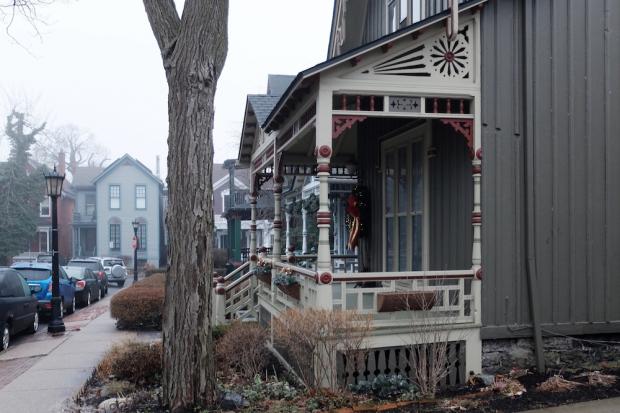Top 10 ways the Green Code Rocks your Earth Day
The Green Code, a top-to-bottom remake of Buffalo’s zoning code, went into effect citywide on April 3. The impact of a zoning code is never felt immediately, and is only evident as each increment of investment in made. If properly applied, over time the new code could be a transformational force for the human and natural environments.
The last code was transformational in all the wrong ways. “A product of the 1950s,” says activist Chuck Banas, who arguably kickstarted the idea of zoning reform back in 2006, “the old code was designed to suburbanize the city, and made most of Buffalo’s compact, walkable, mixed-use neighborhoods illegal.”
The Green Code turns this assumption on its head. Suburban sprawl is out, and mixed-use, walkable neighborhoods are in.
April 22 was Earth Day. As such, let’s count the ways in which the Green Code could make Buffalo more socially, economically, and environmentally sustainable. Here are the top 10:
1. Allows compact development. Density is easier to achieve in each section of the city, with no residential density restrictions in mixed-use zones and reduced density restrictions in residential zones. Lots can be smaller, narrower, and occupied by a larger building footprint. This will help minimize land consumption and promote transportation efficiency, lowering the per-capita carbon footprint.
2. Encourages walking, biking, and transit. Facilitating mixed-use, walkable development and an active public realm is now the official policy goal for every neighborhood. As new development takes place, alternatives to car-dependency should become more viable. By 2035, the new code aims to increase the citywide Walk Score from 65 (“Somewhat Walkable”) to 75 (“Very Walkable”), and the walk/bike/transit commute share from 20% to 35%.
3. Pushes complete streets. The new code includes Buffalo’s first ever design guidelines for public rights-of-way, consistent with the complete streets policy and derived from the ITE Walkable Urban Thoroughfares Manual and NACTO Urban Bikeway Design Guide. This marries the public realm to private development so that each are working toward the goal of more walkable, less car-dependent neighborhoods.
4. Eliminates minimum parking requirements. Buffalo became the first large city in the U.S. to eliminate minimum parking requirements, the culprit behind the scores of underused parking lots driving up stormwater runoff and undermining the public realm. Their elimination will encourage transportation choice and tear down barriers to infill development and adaptive reuse.
5. Preserves open space. Now, fully 14.5 percent of the land area of the city is set aside as protected open space, with new protections added for vacant rail corridors and undeveloped land along the waterfront. The Outer Harbor is the biggest win, with the majority of land once envisioned for heavy industry now permanently protected as an open space resource.
6. Removes barriers to adaptive reuse. Adaptive reuse is now a preferred form of development, helping preserve embodied energy and minimize construction waste from needless demolition. If you want to reuse existing building stock, development approvals are expedited. A new “adaptive reuse permit” allows for certain heritage buildings to be reused for a broader range of uses than are typically allowed. You can even reactivate corner shops and taverns in residential areas, which was nearly impossible to do under the old code.
7. Allows tiny homes. Single and double unit dwellings are no longer subject to density restrictions, and can be built on lots as narrow as 25 feet or 30 feet, and as small as 1,500 or 1,800 square feet, depending on the zone. Existing lots are exempt even from these liberalized standards. If you’d like, you can now build an accessory dwelling unit in the back yard, or establish a home occupation to allow for a zero-commute lifestyle. While you’re at it, make room in the back yard for hens and honey bees, which are now permitted.
8. Embraces dark skies. New outdoor lighting will now have to fully shielded and directed downward, rather than into adjacent properties or up into the night sky. These standards, derived from the International Dark Sky Association’s Model Lighting Ordinance, aim to minimize the impacts of artificial light on natural systems, such as the 265 bird species documented at the Outer Harbor, and help restore visibility in the night sky.
9. Requires green infrastructure. The Great Lakes contain 21 percent of the world’s surface freshwater, all at Buffalo’s doorstep. Naturally, it’s important to think about the impact of stormwater runoff on this resource, and that’s why the new code requires green infrastructure best management practices with new development. Expect more rain gardens, green roofs, and rain barrels in your future.
10. Embraces sustainable energy. Want to put solar panels on your roof, or a residential wind turbine in your back yard? No problem. Renewable energy systems, as well as district heating and cooling systems, are now given legal clarity.
Learn more about the Green Code at buffalogreencode.com. Happy Earth Day, Buffalo!

